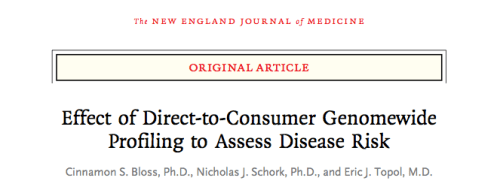This commentary is contributed as part of the guest blogger series Diverse GC Roles.
By Shannon Kieran
 Shannon Kieran is a board-certified Genetic Counselor at Navigenics, a premier personal genome testing laboratory. Shannon’s clinical experience has encompassed a wide range of services from cancer genetics to family planning. As a Genetic Counselor at Navigenics, Shannon works with individuals and healthcare providers to educate them about genetic screening options, discuss test results, and facilitate the medical management of specific genetic predispositions. Additionally, she speaks regularly on the topics of personalized genomics, health privacy protections, and personal and clinical utility of genetic information. Her areas of research and publication have focused on cancer predisposition genetics and patient access to genetic test services.
Shannon Kieran is a board-certified Genetic Counselor at Navigenics, a premier personal genome testing laboratory. Shannon’s clinical experience has encompassed a wide range of services from cancer genetics to family planning. As a Genetic Counselor at Navigenics, Shannon works with individuals and healthcare providers to educate them about genetic screening options, discuss test results, and facilitate the medical management of specific genetic predispositions. Additionally, she speaks regularly on the topics of personalized genomics, health privacy protections, and personal and clinical utility of genetic information. Her areas of research and publication have focused on cancer predisposition genetics and patient access to genetic test services.
After years of working as a traditional cancer counselor in the Bay Area, gaps in the practice of cancer genetic counseling were overwhelming me.
Patients were being declined cancer counseling unless they were deemed pre-eligible for BRCA testing, despite the fact that only 5-10% of breast cancer cases are BRCA-related. Calls were constantly coming in from competent, caring health care providers seeking information for their patients beyond standard testing. I knew there must be more to cancer genetics than the obvious genes and red tape.
That realization led me to take a step away from a traditional genetic counseling environment. In 2007, I took a position as one of two genetic counselors hired by the newly founded personalized genomics company, Navigenics. Navigenics was in its infancy, but they firmly knew where they were headed — into the realm of genetic risk assessment for common diseases including breast, colon, and prostate cancer. Bringing genetic counselors in from the ground up was a new concept for the laboratory industry. But this world of personalized medicine promised to help me understand the 90% of breast cancers that are NOT related to BRCA, and indeed, it has.
From 2007 to 2008, I worked with an integrated team of top-notch research and clinical scientists developing a SNP-based test panel that would illuminate individuals’ predisposition genetic markers to mutifactorial diseases. It was the height of the genome-wide association era, and data regarding common condition genetic susceptibility was pouring out of the peer-reviewed literature weekly. After months of reading, research, lab assay development and content creation, we launched our first service in late 2008.
Today, my colleagues and I offer SNP-based predisposition testing for a handful of cancers, including breast cancer. Every day, I am able to counsel patients by phone about their family history, available and appropriate testing, and often, integrate their Navigenics results. Most of the patients I talk to do not have family history consistent with a BRCA mutation, but are still deeply concerned about their cancer risk. As recent studies have demonstrated, integrating SNP information, along with traditional breast cancer risk models such as GAIL, can improve our ability to discriminate between high and low risk women.
Perhaps even more clinically interesting is the research that has demonstrated disease sub-type SNP based risk assessment (such as estrogen receptor status.) Finally, we are now learning that SNP assessment can inform on risk stratification for BRCA positive women, allowing the clinical team to further delineate each individual risk. Moving beyond traditional breast cancer gene testing has enabled my colleagues and I to provide all women, those with and without BRCA mutations, with risk assessment information beyond the scope of the family tree. This is the personalized counseling I only hoped for just 4 years ago. As a genetic counselor, being able to utilize all of the available tools and information to help my patients get a full picture of their disease risk is truly fulfilling. Genetic counselors are poised to be the clinical leaders in the integration of these new technologies. And thanks to my position at Navigenics, not only have I learned a great deal about building a successful business, but I have also found career fulfillment and true excitement for the future of personalized genomic medicine.





 Your head says forget it
Your head says forget it

